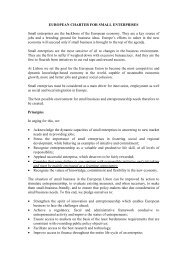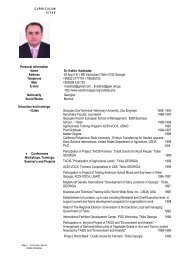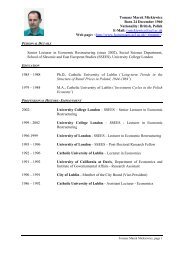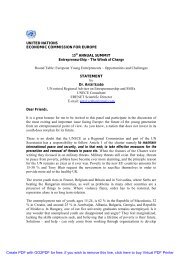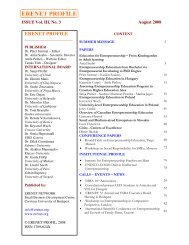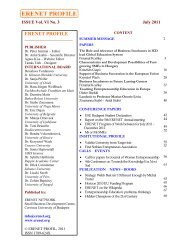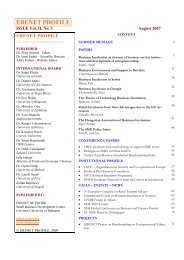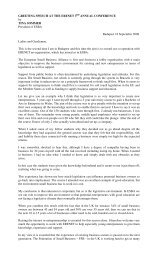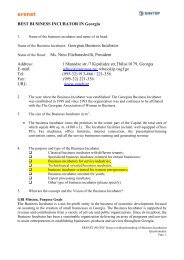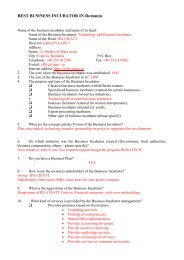3. Hamel, G., Prahalad, C.K. (1994), Competing for <strong>the</strong> Future: Breakthrough <strong>Strategies</strong> for SeizingControl <strong>of</strong> Your Industry <strong>and</strong> Creating <strong>the</strong> Markets <strong>of</strong> Tomorrow, Harvard Business Press, Boston,MA.2. H<strong>of</strong>stede G. 2001 Culture's Consequences: Comparing values behaviors institutions <strong>and</strong>organizations across nations 2 nd edition. Sage. Thous<strong>and</strong> Oaks3. Mintzberg, H. The rise <strong>and</strong> fall <strong>of</strong> strategic planning, Prentice-Hall, Hemel Hempstead, UK (1994).4. Ralston, D. et al, 2005. How do you climb <strong>the</strong> corporate ladder? A multi-regional analysis <strong>of</strong> <strong>the</strong>ethical preferences for influencing superiors. Academy <strong>of</strong> Management Best Papers Proceedings<strong>and</strong> International Division Best Paper Finalist, Honolulu, HI5. Porter, M. (1979) "How competitive forces shape strategy", Harvard business Review, March/April1979.6. Porter, Michael, 1990. The Competitive Advantage <strong>of</strong> Nations. New York: Basic Books.7. Scott, W. R. (1995 <strong>and</strong> 2001). Institutions <strong>and</strong> Organizations. Thous<strong>and</strong> Oaks, CA, Sage8. World Transparency Year Book 2006http://www.transparency.org/news_room/in_focus/2006/cpi_2006__1/cpi_table9. GNI, Atlas method, WDI-200610. http://devdata.worldbank.org/wdi2006/contents/Statisticalmethods.htm5. PREVENTING CONFLICT IN CAUCASUS VIA ENTREPRENEURSHIP AND <strong>SME</strong>DEVELOPMENT – REVIEW OF THE <strong>SME</strong> SECTORS IN ARMENIA,AZERBAIJAN AND GEORGIA 215.1 CHARACTERISTICS OF THE CAUCASIAN TRANSITION ECONOMIESThe three countries <strong>of</strong> <strong>the</strong> South-Caucasus: Armenia, Azerbaijan <strong>and</strong> Georgia lie to <strong>the</strong>south <strong>of</strong> <strong>the</strong> principal Caucasian mountain range, <strong>and</strong> situated on <strong>the</strong> crossroads betweenEurope <strong>and</strong> Asia <strong>the</strong>y absorbed <strong>the</strong> culture <strong>of</strong> both <strong>and</strong> cannot to this day decide with which<strong>the</strong>y have greater affinity. All three were absorbed after 1917 by <strong>the</strong> Soviet Union <strong>and</strong> weremade to bear <strong>the</strong> effect <strong>of</strong> 70 years <strong>of</strong> Soviet rule. Toge<strong>the</strong>r with <strong>the</strong> o<strong>the</strong>r republics <strong>the</strong>ygained independence in 1991.Armenia was highly industrialized <strong>and</strong> specialized in high technology sectors, such aschemicals, electronics, s<strong>of</strong>tware <strong>and</strong> engineering, whose production was exported to <strong>the</strong> o<strong>the</strong>rSoviet Republics, making Armenia vulnerable to events elsewhere. Human capital was highlydeveloped, income equitably distributed, <strong>and</strong> most social indicators (life expectancy, literacy)high; business skills, however, were in short supply.Azerbaijan was famous for its mineral resources (mainly oil <strong>and</strong> gas), with fertileagricultural l<strong>and</strong>, <strong>and</strong> a well-educated labour force with a strong entrepreneurial tradition.Georgia exported agricultural products <strong>and</strong> imported energy-intensive industrialproducts from respectively to <strong>the</strong> former Soviet Union <strong>and</strong> was a popular tourist destination for<strong>the</strong> region.The Caucasus has always been considered a significant strategic <strong>and</strong> geopolitical region.And discovery <strong>of</strong> oil on <strong>the</strong> Caspian Sea shelf not only put <strong>the</strong> Caucasus on <strong>the</strong> map as one <strong>of</strong><strong>the</strong> most economically important regions in <strong>the</strong> world. Despite <strong>the</strong>se economic gains, <strong>the</strong>region continues to face ethnic problems, which may play a negative role in <strong>the</strong> oil industry,<strong>and</strong> cause great concern over <strong>the</strong> future transport <strong>of</strong> oil to <strong>the</strong> global markets. Indeed allconflicts have <strong>the</strong>ir historical, social, economic <strong>and</strong> o<strong>the</strong>r roots. Yet <strong>the</strong> ongoing ethnic conflictin <strong>the</strong> Caucasus is <strong>the</strong> result <strong>of</strong> o<strong>the</strong>r, specific geopolitical factors. As a bridge between Asia <strong>and</strong>Europe, <strong>the</strong> Caucasus is also a frontier separating Christian <strong>and</strong> Muslim worlds. For a long time,21 Prepared by Dr. Antal SZABÓ, UNECE retired Regional Adviser on <strong>Entrepreneurship</strong> <strong>and</strong> <strong>SME</strong>s <strong>and</strong> Dr. AnnaPetrosyan, Expert <strong>of</strong> <strong>the</strong> <strong>SME</strong> Department <strong>of</strong> <strong>the</strong> Ministry <strong>of</strong>84
<strong>the</strong> region was <strong>the</strong> site <strong>of</strong> fighting between <strong>the</strong> empires. The influence <strong>of</strong> different, sometimesconflicting imperial <strong>and</strong> religious interests would have been sufficient factors prompting <strong>the</strong>current ethnic conflicts in <strong>the</strong> Caucasus, even if <strong>the</strong> region was mono- ethnic. Yet, <strong>the</strong>Caucasus is one <strong>of</strong> <strong>the</strong> most poly-ethnic regions in <strong>the</strong> world, comprising many ethnic groupsthat have uniquely different languages, religions <strong>and</strong> political orientations. Political <strong>and</strong> ethnicboundaries that do not coincide with each o<strong>the</strong>r, however, complicate <strong>the</strong> regional situation.The former Soviet Union bequea<strong>the</strong>d a number <strong>of</strong> problems to <strong>the</strong> Caucasus countries,including artificially drawn national borders <strong>and</strong> centrally planned economies that were heavilydependent on Russia. Even before Azerbaijan <strong>and</strong> Armenia declared independence, fightingbroke out in 1988 between <strong>the</strong> <strong>the</strong>n-Soviet republics over <strong>the</strong> disputed area <strong>of</strong> Nagorno-Karabakh, <strong>and</strong> separatist conflicts sparked in Georgia soon after independence. Some <strong>of</strong> <strong>the</strong>regional conflicts that flared in different parts <strong>of</strong> <strong>the</strong> Caucasus throughout <strong>the</strong> 1990's are nowdormant, but few have been <strong>of</strong>ficially resolved.Source: UNECE databaseUpon independence <strong>the</strong>se countries were saddled with distortion typical <strong>of</strong> centrallyplanned economies-economic distortion <strong>and</strong> contraction, deterioration in social services <strong>and</strong>infrastructure, loss <strong>of</strong> traditional markets <strong>and</strong> a rise in poverty. Prices <strong>and</strong> wages were setadministratively; trade <strong>and</strong> distribution were conducted by government monopolies, <strong>and</strong> <strong>the</strong>most enterprises were state-owned. Because activity was mainly directed from Moscow,government <strong>and</strong> enterprise capacity was quite limited.Current government social economic policies aim at accelerating structural reforms <strong>and</strong>keeping <strong>the</strong> economies on a sustainable growth path while improving social security provision.Appropriate development strategies to create employment <strong>and</strong> eliminate poverty have to beadopted.In consequence <strong>of</strong> several efforts by PERMIS BSEC, UN <strong>and</strong> o<strong>the</strong>r internationalorganizations, <strong>the</strong> Konrad Adenauer Foundation, GTZ etc. <strong>the</strong> stakeholders slowly started tounderst<strong>and</strong> <strong>the</strong> role <strong>of</strong> <strong>the</strong> entrepreneurship in <strong>the</strong>se three countries, however, from politicalreasonl <strong>the</strong>y are still far from a crystal-clear triad.85
- Page 4 and 5:
1. SME DECLARATION AND WORKING GROU
- Page 6 and 7:
While comparing the BSEC and EU doc
- Page 8 and 9:
cooperation with the United Nations
- Page 10 and 11:
GENERAL ASSESSMENT OF THE BSEC WG O
- Page 12 and 13:
“Armenia's new law introduces a n
- Page 14 and 15:
(iii)Share of the labor force of SM
- Page 16 and 17:
The following data represents some
- Page 18 and 19:
RankDocuments for export(number)Tra
- Page 20 and 21:
• Industrial zones/Business incub
- Page 22 and 23:
3.1.4. FINANCING SMEsProf. Dr. Sela
- Page 24 and 25:
• the loan is secured with movabl
- Page 26 and 27:
3.1.4.3. Mutual and loan guarantee
- Page 28 and 29:
introduction of e-signatures, only
- Page 30 and 31:
The Code of Conduct for Civil Serva
- Page 32 and 33:
Trading Across Borders Enforcing Co
- Page 34 and 35: as with all non-governmental organi
- Page 36 and 37: Bulgarian SMEs obtain additional ca
- Page 38 and 39: • Project BG 2004/016-711.11.04 -
- Page 40 and 41: usiness is not approaching them oft
- Page 42 and 43: • Romanian citizens are recognize
- Page 44 and 45: The preparatory project of the NDP
- Page 46 and 47: • To support participation in eco
- Page 48 and 49: In 2004, the National Institute of
- Page 50 and 51: Incubators host on average 11 SME,
- Page 52 and 53: Programs. The program is implemente
- Page 54 and 55: development instrument is extremely
- Page 56 and 57: accounting standards, including med
- Page 58 and 59: corporations and open held corporat
- Page 60 and 61: promoting SME sector, cooperation w
- Page 62 and 63: • for unemployed (micro credit)
- Page 64 and 65: are private pension funds, broker h
- Page 66 and 67: very early steps of its democratic
- Page 68 and 69: Another negative factor that is mor
- Page 70 and 71: economy. The so called in the organ
- Page 72 and 73: Federal funds, private capital, esp
- Page 74 and 75: 4.3. MOLDOVATable 14.Dimensions Neg
- Page 76 and 77: Related andsupportingindustriesDome
- Page 78 and 79: Technological:Internetaccessibility
- Page 80 and 81: Domesticdemand• Still not many pe
- Page 82 and 83: international investments• Govern
- Page 86 and 87: 5.2 DEVELOPMENT OF THE SME SECTOR I
- Page 88 and 89: General Characteristic of SME Devel
- Page 90 and 91: Index of SME Development in Armenia
- Page 92 and 93: The same problem exists in getting
- Page 94 and 95: SME support infrastructure in Armen
- Page 96 and 97: 5 million was provided by UNDP and
- Page 98 and 99: 5.3 DEVELOPMENT OF THE SME SECTOR I
- Page 100 and 101: Diagram 1. The number of small ente
- Page 102 and 103: The privatization process of object
- Page 104 and 105: 13.Cabinet Provision on “Distribu
- Page 106 and 107: 5.3.3. SME support infrastructure i
- Page 108 and 109: The role of the state in technical
- Page 110 and 111: General situation of credit marketT
- Page 112 and 113: After creation and starting impleme
- Page 114 and 115: At the meantime, small enterprise s
- Page 116 and 117: Table. 32.Ease of businessDoingBusi
- Page 118 and 119: people who start small businesses t
- Page 120 and 121: are salaried and the medium - sized
- Page 122 and 123: Technology Foresight in Greece 2001
- Page 124 and 125: Greek VC market started to develop
- Page 126 and 127: In the area of bankruptcy and restr
- Page 128 and 129: enterprises. According to TURKSTAT,
- Page 130 and 131: small size enterprise or micro ente
- Page 132 and 133: industrial enterprises. Undersecret
- Page 134 and 135:
individuals, rather than well struc
- Page 136 and 137:
7. SUGGESTIONS FOR THE SME DEVELOPM
- Page 138 and 139:
Annex 1.MAP OF THE BLACK SEA COUNTR
- Page 140 and 141:
17-18 June 2005 1 st Moscow Interna
- Page 142 and 143:
ARMENIASTRENGTHS• Application of
- Page 144 and 145:
BULGARIASTRENGHT• Flexibility and
- Page 146 and 147:
GREECESTRENGHT• They have a vital
- Page 148 and 149:
ROMANIASTRENGHTWEAKNESS• Stabilis
- Page 150 and 151:
REPUBLIC OF SERBIASTRENGHT• Longe
- Page 152 and 153:
UKRAINESTRENGTHS• Well educated l
- Page 154 and 155:
In compliance with the Resolution m
- Page 156 and 157:
1. Please provide definition of SME
- Page 158 and 159:
7. Did you establish a dedicated bo
- Page 160:
11. Do you have any suggestions for



